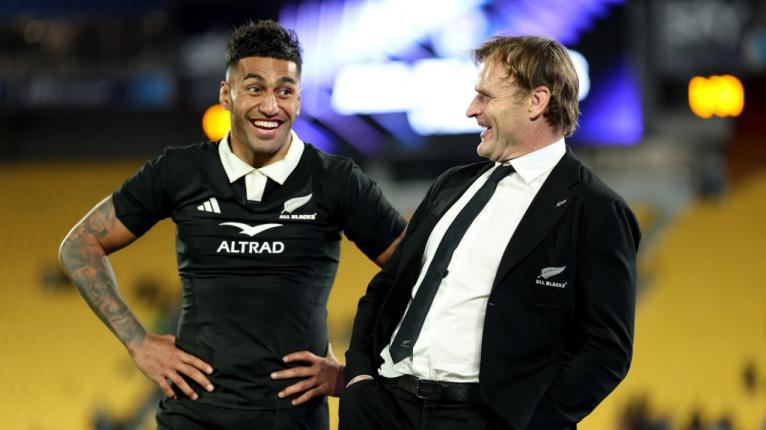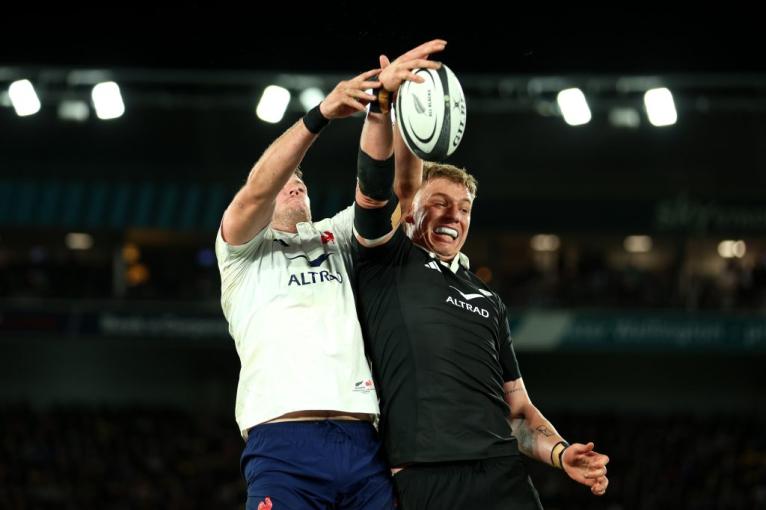When Scott Robertson was coach of the Crusaders, he famously liked to theme campaigns as a way of capturing the imagination of his players. He’s not replicating the same formula with the All Blacks, but he has hit on a broad, long-term project which he is calling 4-4-4.
The numbers stand for his belief the All Blacks will need to have four Test-quality players in each position by the end of his fourth year in charge if they are to win a fourth World Cup in 2027.
 Scott Robertson will be satisifed with the depth across most positions in his New Zealand setup (Photo by Phil Walter/Getty Images)
Scott Robertson will be satisifed with the depth across most positions in his New Zealand setup (Photo by Phil Walter/Getty Images)
This is typical Robertson – it might seem a bit gimmicky and contrived, but 4-4-4 is a simple and measurable way for him and his coaching staff, as well as the public and media, to assess how well the team is tracking in its quest for World Cup glory.
It’s a means to keep him accountable to delivering on a longer-term vision, something he welcomes after not always aligning his selections last year with his goal of widening the talent pool.
He admits in 2024, he was at times conservative – and should have been willing to inject untried players into certain games.
How do I create enough opportunities to bring through talent, but also win the Test in front of us? It’s a balancing act.
There was no better example than the last match of the season against Italy, when he rejected the chance to give Stephen Perofeta, Ruben Love, Billy Proctor and Samipeni Finau starts, and instead asked his top team to play for a fourth consecutive week.
It was a game crying out for the All Blacks to see what their fringe candidates could do – partly to find out, but also to give some of the big names a rest.
“You always look at yourself as the leader,” Robertson said in June this year, just before the three-Test series against France.
“How do I create enough opportunities to bring through talent, but also win the Test in front of us? It’s a balancing act.
 New Zealand opted not to rotate heavily for their final Test match of 2024 against Italy in Turin (Photo by Francesco Scaccianoce/Getty Images)
New Zealand opted not to rotate heavily for their final Test match of 2024 against Italy in Turin (Photo by Francesco Scaccianoce/Getty Images)
“You feel like you could have been braver with a couple of combinations, and some you’re extremely happy with. We had 10 debutants, and some absolutely flourished.
“I understand everyone will have an opinion about what I do, which you love because they care so much about it. You do things right, but there are going to be some things that are not.
“Could you have done it better? Probably. That’s why you’ve got to stay your course, keep the trust, and keep the instinct that comes with coaching.”
It was with that missed opportunity in Turin front of mind that Robertson came into the July series with a stated goal of winning 3-0 but also ensuring everyone in the 33-man squad got on the park at some stage.
He achieved both goals, but in specific regard to 4-4-4, he had a couple of wins, but also a few unexpected setbacks.
That ability to dominate a scrum in the final quarter was beyond the All Blacks last year, something Robertson noted when asked about the value of winning set-piece penalties at the death.
What has become clear is the All Blacks probably have the requisite depth of talent they need at prop and lock. Their set-piece work was strong throughout, particularly their scrummaging, which earned penalties late in the first and third Tests.
That ability to dominate a scrum in the final quarter was beyond the All Blacks last year, something Robertson noted when asked about the value of winning set-piece penalties at the death.
“It is critical,” he said. “It is a massive factor we learned last year the other way. It is everything we have asked for and trained for.”
With Tamaiti Williams due back from injury for the Rugby Championship and Ofa Tu’ungafasi likely to return next year, the All Blacks have the front-row stocks they need for 2027.
There is a bit of work to do at hooker, where Codie Taylor confirmed he’s the country’s best, and his understudy, Samisoni Taukaei’aho, has parts of his game which need sharpening up.
Brodie McAlister made his debut in Hamilton and carried and mauled well, but three lineouts were lost on his watch. New Zealand also have Asafo Aumua waiting to return from injury.
Because 22-year-old Fabian Holland made such a telling and impactful introduction to international rugby, they now have in him, Scott Barrett, Tupou Vaa’i and Patrick Tuipulotu, four genuine locks.
Holland will arguably be the find of the season, the 6ft 8ins, 125kg Dutchman smashing through 240 minutes of intensely physical work, while also showing a number of deft touches.
 Fabian Holland enjoyed an influential and dynamic introduction to the Test arena (Photo by Hagen Hopkins/Getty Images)
Fabian Holland enjoyed an influential and dynamic introduction to the Test arena (Photo by Hagen Hopkins/Getty Images)
“He’s got a great engine hasn’t he,” Robertson said. “We keep trying to get him off the field but he just keeps going and going.
“When you lose a couple of locks, which we did, we just had to play him and we did and I though he was remarkable and got better across the three. He’s a great kid.”
The picture wasn’t so clear cut in the loose forwards where Vaa’i’s two appearances at blindside were enough to build confidence he could be an option there.
Du’Plessis Kirifi came up to speed nicely as a ball-winning specialist and Ardie Savea was his usual brilliant self.
But Luke Jacobson didn’t manage to play because of injury, and there is a feeling Christian Lio-Willie, willing and fearless, will ultimately be too small to have any impact against the likes of South Africa, while Finau didn’t get enough time to suggest he’s going to become the aggressive but disciplined No. 6 they are looking for.
Where Robertson is going to feel a level of concern is at halfback and first-five, because the French series highlighted there is a big gap between the first-choice picks of Cameron Roigard and Beauden Barrett, and the back-up duo Cortez Ratima and Damian McKenzie.
Robertson will get Wallace Sititi back from surgery shortly, who adds to the stockpile of players who can play six, and may draft Simon Parker into the Rugby Championship squad.
Parker is comfortable at eight and six, and at 6ft 6ins and 117kg is the grizzly bear the All Blacks want in both roles.
Savea and Lio-Willie are both options at eight, as is Jacobson and on the openside, there is Savea, Kirifi, Dalton Papali’i and Peter Lakai when he returns from injury.
The All Blacks aren’t quite four deep in each position, but they would have to suffer quite an extraordinary injury crisis to feel they didn’t have enough depth to cope – and that’s without considering the possibility of Shannon Frizell coming home next year.
Where Robertson is going to feel a level of concern is at halfback and first-five, because the French series highlighted there is a big gap between the first-choice picks of Cameron Roigard and Beauden Barrett, and the back-up duo Cortez Ratima and Damian McKenzie.
As former All Black Israel Dagg said on his Sport Nation radio show: “Damian still looks a little bit unsure, he looks deflated, maybe trying a bit too hard and outside of that there’s no-one else.
“You’ve got Ruben Love, who had his first start at 15; is he a genuine option to go into 10 or do you look outside of this team if Beaudy is not available?
 Ruben Love has been touted as a possible understudy to Beauden Barrett (Photo by Hagen Hopkins/Getty Images)
Ruben Love has been touted as a possible understudy to Beauden Barrett (Photo by Hagen Hopkins/Getty Images)
“At nine, if Cam Roigard goes down, how do we feel? I’m nervous. Cortez, yes, he’s very good with ball in hand but his kicking game needs a whole lot of work, bar that moment when he set up Will Jordan.
“Outside of that, we’ve only got one option and that’s going back to the 10 because his box-kicks are a little bit too long, they’re just not on the money for our chasers.”
If Richie Mo’unga doesn’t return from Japan next year, the All Blacks may have to look at giving Love more experience at 10 between now and the World Cup to see if he can develop into a more astute game manager than McKenzie, who looks like his best role is coming off the bench and having a licence to play full-back and first receiver.
The French series also indicated Quinn Tupaea is a promising 12 but a long way behind Jordie Barrett; that Proctor might be the right long-term option at centre but again, is a work in progress.
And perhaps the most pressing issue is the need to build a deeper and more varied array of talent in the outside backs.
Will Jordan was brilliant either at full-back or on the wing, and Rieko Ioane, after a slow first Test, was getting back into the wing groove by the second.
But Sevu Reece looked, again, like he lacks the top-end pace to play wing at this level, Emoni Narawa was tried once and then discarded suggesting he’s not someone they believe in and Caleb Clarke didn’t feature because of a serious ankle injury.
Leicester Fainga’anuku will be available for the end of year tour, but it feels like Robertson has no option but to elevate at last one of an emerging cluster of wings that includes Leroy Carter, Chay Fihaki or Caleb Tangitau into the Rugby Championship squad.
Project 4-4-4 is largely on track but it needs a bit more attention at nine and 10, and for a new weapon to be discovered on the wing.
